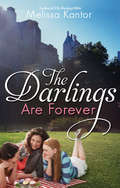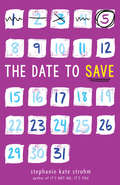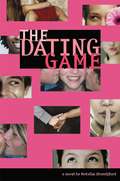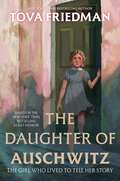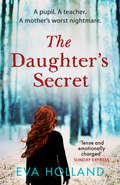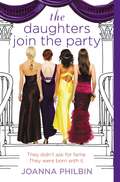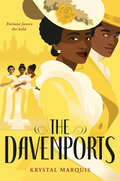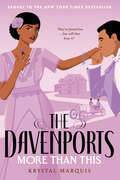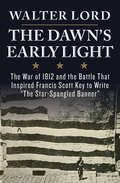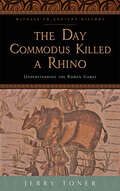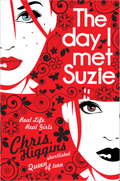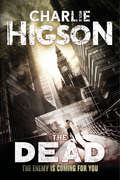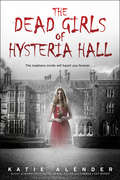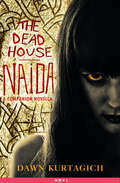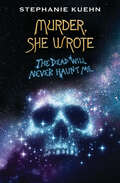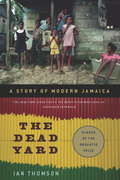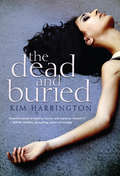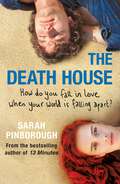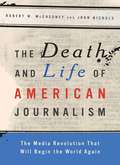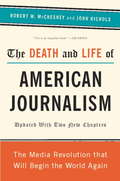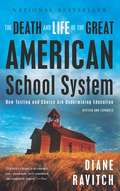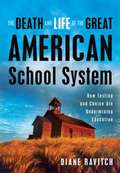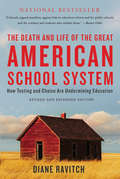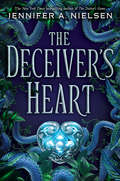- Table View
- List View
The Darlings Are Forever (The\darlings Ser.)
by Melissa KantorJane, Victoria, and Natalya. Together, they are the Darlings. Best friends forever. They have matching necklaces, their own table at Ga Ga Noodle, and even a shared motto: May you always do what you're afraid of doing. When the friends begin freshman year at three different high schools in distant corners of New York City, they promise to live by their motto and stay as close as ever. The Darlings know they can get through anything as long as they have each other. But doing scary new things is a lot easier with your friends beside you. And now that the girls aren't spending all their time together, everything they took for granted about their friendship starts to feel less certain. They can't help but wonder, will they really be the Darlings forever?The first book in an exciting new series by bestselling author Melissa Kantor, The Darlings Are Forever will speak to any girl who has ever had a best friend.
The Date to Save
by Stephanie Kate StrohmAfter a scheduling mishap occurs one student tracks how her high school's homecoming game, the academic battle, and class election all ended up on the same day with hilarious results!The word is out...BROOKS MANDEVILLE, quarterback: Friday is the homecoming game and dance. It is a very big deal.NATALIE WAGNER, marching band clarinet: Our band's halftime show performances are legendary, even if our football team isn't. CINTHIA ALVAREZ, Academic Battle team member: Our Academic Battle team has won five years in a row. This Friday, it'll be six.TANNER ERICKSEN, sophomore class candidate for vice president: Holly has to win the election for class president this Friday!HOLLY CARPENTER, cheerleader, Academic Battle team member, class president candidate: Friday? Everything is on Friday? How can I be in three places at once?COLIN VON KOHORN, editor-in-chief of the Prepster: This kind of scheduling incompetence could only have come straight from the top.ANGELICA HUTCHERSON, reporter-at-large: I talked to everyone and my article is going to crack this story wide open...This is what happens on the wildest day in the history of high school!
The Dating Game (The Dating Game #1)
by Natalie StandifordMeet sophomores Madison, Holly and Lina. When the Dating Game website that they create forclass becomes a campus hit, they become the match-making masters of their school and, they hope, their lives.Will Madison ever learn how to kiss correctly? Is it okay for Lina to share how far she's gone with her guy with her girlfriends? And how many dates will it take Holly to tell if he's really 'the one'?
The Daughter of Auschwitz: The Girl Who Lived to Tell Her Story
by Tova FriedmanIn this powerful middle grade adaptation of the bestselling adult memoir of the same name, New York Times bestselling author Tova Friedman recounts her experiences as one of the youngest survivors of the Holocaust.At the tender age of five years old, Tola Grossman was sent to a Nazi labor camp. As World War II was breaking out around them, the only thing Tola and her parents were left with was the instinct to survive at all costs. Tola’s life became a series of miraculous close calls, from being saved from a gas chamber to successfully hiding from the Nazis as they were rounding people up. In this evocative account of one young girl’s survival, Tova Friedman chronicles the atrocities she witnessed while at Auschwitz and, ultimately, the sources of hope and courage she and her family found to persist against all odds.
The Daughter's Secret: A gripping psychological suspense perfect for fans of Liane Moriarty
by Eva HollandMy daughter is a liar. A liar, liar, liar. And I'm starting to see where she gets it from. When Rosalind's fifteen-year-old daughter, Stephanie, ran away with her teacher, this ordinary family became something it had never asked to be. Their lives held up to scrutiny in the centre of a major police investigation, the Simms were headline news while Stephanie was missing with a man who was risking everything. Now, six years on, Ros takes a call that will change their lives all over again. He's going to be released from prison. Years too early. In eleven days' time. As Temperley's release creeps ever closer, Ros is forced to confront the events that led them here, back to a place she thought she'd left behind, to questions she didn't want to answer. Why did she do it? Where does the blame lie? What happens next?
The Daughters Join the Party (The Daughters #4)
by Joanna PhilbinThey didn't ask for fame. They were born with it. In the third Daughters novel, The Daughters Take the Stage, Hudson found her own place in "the family business," aka: show business. Now, for the first time, readers will meet Emma Conway, daughter of a powerful New York State Senator. Emma has never fit into the sweater-set-wearing world of her political family, opting for purple hair and Chuck Taylors to keep herself out of countless photo ops, but when she accidentally lets her father's presidential plans slip on national television, Emma finds herself thrown into the spotlight. Facing pressure to be the perfect First Daughter-in-training, Emma must learn to speak up for herself and for what she believes in. Thankfully, she has her new friends and fellow daughters - Lizzie, Carina, and Hudson - to help her along the way.
The Davenports
by Krystal Marquis*Instant New York Times Bestseller*The Davenports delivers a totally escapist, swoon-worthy romance while offering a glimpse into a period of African American history often overlooked."The perfect read for fans of escapist historical fiction.&” —NBC&’s TODAYThe Davenports are one of the few Black families of immense wealth and status in a changing United States, their fortune made through the entrepreneurship of William Davenport, a formerly enslaved man who founded the Davenport Carriage Company years ago. Now it's 1910, and the Davenports live surrounded by servants, crystal chandeliers, and endless parties, finding their way and finding love—even where they&’re not supposed to.There is Olivia, the beautiful elder Davenport daughter, ready to do her duty by getting married . . . until she meets the charismatic civil rights leader Washington DeWight and sparks fly. The younger daughter, Helen, is more interested in fixing cars than falling in love—unless it&’s with her sister&’s suitor. Amy-Rose, the childhood friend turned maid to the Davenport sisters, dreams of opening her own business—and marrying the one man she could never be with, Olivia and Helen&’s brother, John. But Olivia&’s best friend, Ruby, also has her sights set on John Davenport, though she can&’t seem to keep his interest . . . until family pressure has her scheming to win his heart, just as someone else wins hers.Inspired by the real-life story of the Patterson family, The Davenports is the tale of four determined and passionate young Black women discovering the courage to steer their own path in life—and love."The Davenports has it all: romance, heartbreak, courage." —Ebony"A fresh, utterly enchanting read.&” —Ayana Gray, New York Times bestselling author of the Beasts of Prey trilogy"Deftly written . . . A dazzling debut." —Kirkus (starred review)"Stunningly wrought . . . Presents a cast of take-charge women." —PW (starred review)"It has the compulsive readability of Gossip Girl." —Booklist (starred review)"Compelling . . . distinct and satisfying." —BCCB"Skilled . . . Well-written . . . Sure to please." —SLJ"If this whole series existed right now, I&’d tear through it to the exclusion of everything else in my life." —Teen Librarian Toolbox
The Davenports: More Than This
by Krystal MarquisThe anticipated sequel to the instant New York Times bestseller featuring escapist romance and a wealthy Black family in 1910s ChicagoLike the blazing Chicago sun, the drama is heating up for the Davenports and their social set. Before the summer of 1910 drops its last petal, the lives—and loves—of these four young women will change in ways they never could have imagined:Newly engaged Ruby Tremaine is eagerly planning her wedding to the love of her life when a nasty rumor threatens her reputation and her marriage. Olivia Davenport has committed to the social justice cause and secretly hopes she&’ll be reunited with dashing lawyer Washington DeWight—until her parents decide she&’s to marry someone else. Amy-Rose Shepherd is making her lifelong wish of owning a salon come true, but when an incident forces her to return to Freeport Manor, she&’s back in the path of John Davenport, who still holds her heart. Helen Davenport is determined to get over her own heartbreak and bring the Davenport Carriage Company into the new century, even if it means teaming up with a thrill-seeking racecar driver who just loves to get under her skin.Inspired by the real-life story of the Patterson family, More Than This is the second book in critically adored Davenports series, following four empowered and passionate young Black women as they navigate a rapidly changing society and discover the courage to steer their own paths in life—and love.&“The Davenport universe has history, humor, and heart baked into it . . . Breezy and fluid prose supports the love-filled merry-go-round of will-they-won&’t-they storylines.&” —Kirkus
The Dawn's Early Light: The War of 1812 and the Battle That Inspired Francis Scott Key to Write "The Star-Spangled Banner" (Maryland Paperback Bookshelf Ser.)
by Walter LordLord's stunning account of the War of 1812, when a young nation won its independence once and for allAt the dawn of the nineteenth century, the great powers of Western Europe treated the United States like a disobedient child. Great Britain blocked American trade, seized its vessels, and impressed its sailors to serve in the Royal Navy. America's complaints were ignored, and the humiliation continued until James Madison, the country's fourth president, declared a second war on Great Britain. British forces descended on the United States, shattering its armies and burning its capital, but America rallied, and survived the conflict with its sovereignty intact. This is the story of the turning points of that strange war, which inspired the writing of "The Star Spangled Banner" and led to the Era of Good Feeling that all but erased partisan politics in America for almost a decade. It was in 1812 that America found its identity, and first assumed its place on the world stage.
The Day Commodus Killed a Rhino: Understanding the Roman Games (Witness to Ancient History)
by Jerry TonerIn ancient times, the Roman games—that heady cocktail of mass slaughter, gladiatorial combat, and chariot racing—made strong political, social, and cultural statements.The Roman emperor Commodus wanted to kill a rhinoceros with a bow and arrow, and he wanted to do it in the Colosseum. Commodus’s passion for hunting animals was so fervent that he dreamt of shooting a tiger, an elephant, and a hippopotamus; his prowess was such that people claimed he never missed when hurling his javelin or firing arrows from his bow. For fourteen days near the end of AD 192, the emperor mounted one of the most lavish and spectacular gladiatorial games Rome had ever seen. Commodus himself was the star attraction, and people rushed from all over Italy to witness the spectacle. But this slaughter was simply the warm-up act to the main event: the emperor was also planning to fight as a gladiator.Why did Roman rulers spend vast resources on such over-the-top displays—and why did some emperors appear in them as combatants? Why did the Roman rabble enjoy watching the slaughter of animals and the sight of men fighting to the death? And how best can we in the modern world understand what was truly at stake in the circus and the arena? In The Day Commodus Killed a Rhino, Jerry Toner set out to answer these questions by vividly describing what it would have been like to attend Commodus’ fantastic shows and watch one of his many appearances as both hunter and fighter. Highlighting the massive logistical effort needed to supply the games with animals, performers, and criminals for execution, the book reveals how blood and gore were actually incidental to what really mattered. Gladiatorial games played a key role in establishing a forum for political debate between the rulers and the ruled. Roman crowds were not passive: they were made up of sophisticated consumers with their own political aims, which they used the games to secure. In addition, the games also served as a pure expression of what it meant to be a true Roman. Drawing on notions of personal honor, manly vigor, and sophisticated craftsmanship, the games were a story that the Romans loved to tell themselves about themselves.
The Day I Met Suzie
by Chris Higgins'My boyfriend could get into trouble if he gets caught. He could go to jail.' I moan softly. 'So could I.''Anything you tell me is completely confidential.' I sigh deeply. What have I got to lose? 'I wouldn't know where to begin.''At the beginning?' she says. 'In your own words.'So that's what I do. I start at the beginning like she says.The day I met Suzie.Indigo (Indie) rings the Samaritans. She is frightened and desperate with no one to turn to. Over the course of one long night, Indie tells her story to the person on the end of the phone. She realises that her friend Suzie has taken over her home, her friends, her work, her boyfriend - and her life. After every few chapters we are brought back to the present moment, and see how piecing the story together helps Indie progress towards resolution.
The Dead (An Enemy Novel #2)
by Charlie HigsonThe disease only affects people sixteen or older. It starts with the symptoms of a cold. Then the skin begins to itch, and spots appear--spots that soon turn into pus-filled boils. But the worst part is the headache, the inner voices that tell you that you need to eat them . . . the young ones. When the Disaster strikes, the world turns upside down for Ed, Jack, Bam and the other students at Rowhurst School. The parents and older siblings they left back at home are dead--or worse. Once the teachers go on the attack, the kids know it's time to escape and make their way to the city. It's got to be better in London . . . or will it be worse?
The Dead Girls of Hysteria Hall (Point Ser.)
by Katie AlenderIN THIS ASYLUM, YOUR MIND PLAYS TRICK ON YOU ALL THE TIME ...Delia's new house isn't just a house. Long ago, it was the Piven Institute for the Care and Correction of Troubled Females -- an insane asylum nicknamed "Hysteria Hall." However, many of the inmates were not insane, just defiant and strong willed. Kind of like Delia herself.But the house still wants to keep "troubled" girls locked away. So, in the most horrifying way, Delia becomes trapped. And that's when she learns that the house is also haunted.Ghost girls wander the hallways in their old-fashioned nightgowns. A handsome ghost boy named Theo roams the grounds. Delia learns that all the spirits are unsettled and full of dark secrets. The house, too, harbors shocking truths within its walls -- truths that only Delia can uncover, and that may set her free. And she'll need to act quickly -- before the house's power overtakes everything she loves.Katie Alender brings heart-pounding suspense, gorgeous writing, and a feminist twist to this tale of memories and madness.
The Dead House: A Companion Novella
by Dawn KurtagichA digital short story from The Dead House author Dawn Kurtagich There is a box. A box that should never have been discovered. And a warning beneath the lid. This was for Kaitlyn. It was a mistake. Forget this box and leave the Isle. Don't look any further. I'm begging you. N.C.D. 2006After the inferno that swept through Elmbride High, claiming the lives of three teenagers and causing one student, Carly Johnson, to disappear, Naida Chounan-Dupre was locked away for the good of society.But that wasn't the end of the story. Because you can't play with the devil and not pay the price.The chilling, psychological horror of The Dead House returns with never-before-seen footage of the Naida tapes.
The Dead Will Never Haunt Me (Murder, She Wrote #3)
by Stephanie KuehnSmall town murders.Big time thrills.The final installment in the suspenseful, modern update of the classic mystery TV series. Perfect for fans of One of Us Is Lying, Sadie, and Gossip Girl."What does it mean if our own sense of right and wrong isn't enough to keep us from committing the unspeakable?"When Beatrice Fletcher joins her father on a work trip to the University of New Mexico, she knows she's sacrificing time with her friends back in Cabot Cove trying to solve the last clue of an enigmatic game they've been playing. Yet it's worth it if it means she can interview celebrated film studies professor William Vance, whose newest documentary touches on a murderous cult, a misdirected bombing, and a tragedy from Bea's mother's childhood.But when a string of poisonings targets girls in Vance's film program, Bea has more to worry about than ancient family history. Someone knew she was coming to campus and why. And now that she's insinuated herself into the students' circle, could she be next on the hit list? Like her great aunt Jessica, Bea will need cunning and logic to get to the bottom of the attacks and figure out what all of it has to do with the game back home.And time is running out...
The Dead Yard: A Story of Modern Jamaica
by Ian ThomsonThis is a journalistic travelogue that paints a societal portrait of modern Jamaica as riven by deep-seated corruption and violence. The author meets with and reports on the views of a swathe of Jamaicans, including many elites, as they reflect on Jamaican history and politics, relations with the US and Britain (Jamaica's former colonial master), race relations, gang and police violence, poverty, and other issues. As the author admits, nostalgia for British imperialism runs throughout the pages, although he himself says that Jamaican independence was both right and necessary. This is a paperbound reprint of a work first published in 2009 Annotation ©2011 Book News, Inc. , Portland, OR (booknews. com)
The Dead and Buried
by Kim HarringtonA haunted house, a buried mystery, and a very angry ghost make this one unforgettable thriller.Jade loves the house she's just moved into with her family. She doesn't even mind being the new girl at the high school: It's a fresh start, and there's that one guy with the dreamy blue eyes. . . . But then things begin happening. Strange, otherworldly things. Jade's little brother claims to see a glimmering girl in his room. Jade's jewelry gets moved around, as if by an invisible hand. Kids at school whisper behind her back like they know something she doesn't. Soon, Jade must face an impossible fact: that her perfect house . . . is haunted. Haunted by a ghost who's seeking not just vengeance, but the truth. The ghost of a girl who ruled Jade's school -- until her untimely death last year. It's up to Jade to put the pieces together before her own life is at stake. As Jade investigates the mystery, she discovers that her new friends in town have more than a few deep, dark secrets. But is one of them a murderer?
The Death House
by Sarah PinboroughFrom the Sunday Times bestselling author of 13 Minutes comes a heart-breaking, heart-stopping tale of love, life and death which will take your breath away.Toby is a boy who has forgotten how to live.Clara is a girl who was born to die.Toby's life was perfectly normal . . .Taken from his family, Toby now lives in the Death House. Isolated from the outside world the inhabitants of are watched for any signs of a mysterious illness . . .Clara was a girl who had everything. Adored by her friends and her family, her life was destined for greatness. Now, Clara is the newest resident of the Death House and she's determined not to allow her life to end there.This is Toby and Clara's story.Sarah Pinborough is the SUNDAY TIMES BESTSELLING author of BEHIND HER EYES.You can learn more about Sarah Pinborough at www.sarahpinborough.com, or by following @SarahPinborough on twitter.
The Death and Life of American Journalism
by Robert W. Mcchesney Nichols JohnDaily newspapers are closing across America. Washington bureaus are shuttering; whole areas of the federal government are now operating with no press coverage. International bureaus are going, going, gone. Journalism, the counterbalance to corporate and political power, the lifeblood of American democracy, is not just threatened. It is in meltdown. In The Death and Life of American Journalism, Robert W. McChesney, an academic, and John Nichols, a journalist, who together founded the nation’s leading media reform network, Free Press, investigate the crisis. They propose a bold strategy for saving journalism and saving democracy, one that looks back to how the Founding Fathers ensured free press protection with the First Amendment and provided subsidies to the burgeoning print press of the young nation.
The Death and Life of American Journalism: The Media Revolution That Will Begin the World Again
by John Nichols Robert McchesneyAmerican journalism is collapsing as newspapers and magazines fail and scores of reporters are laid off across the country. Conventional wisdom says the Internet is to blame, but veteran journalists and media critics Robert W. McChesney and John Nichols disagree. The crisis of American journalism predates the Great Recession and digital media boom. What we are witnessing now is the end of the commercial news model and the opportune moment for the creation of a new system of independent journalism, one subsidized by the public and capable of safeguarding our democracy.
The Death and Life of the Great American School System
by Diane RavitchA passionate plea to preserve and renew public education, The Death and Life of the Great American School System is a radical change of heart from one of America's best-known education experts. Diane Ravitch--former assistant secretary of education and a leader in the drive to create a national curriculum--examines her career in education reform and repudiates positions that she once staunchly advocated. Drawing on over forty years of research and experience, Ravitch critiques today's most popular ideas for restructuring schools, including privatization, standardized testing, punitive accountability, and the feckless multiplication of charter schools. She shows conclusively why the business model is not an appropriate way to improve schools. Using examples from major cities like New York, Philadelphia, Chicago, Denver, and San Diego, Ravitch makes the case that public education today is in peril. Ravitch includes clear prescriptions for improving America's schools: leave decisions about schools to educators, not politicians or businessmen devise a truly national curriculum that sets out what children in every grade should be learning expect charter schools to educate the kids who need help the most, not to compete with public schools pay teachers a fair wage for their work, not "merit pay" based on deeply flawed and unreliable test scores encourage family involvement in education from an early age The Death and Life of the Great American School System is more than just an analysis of the state of play of the American education system. It is a must-read for any stakeholder in the future of American schooling.
The Death and Life of the Great American School System
by Diane RavitchA passionate plea to preserve and renew public education,The Death and Life of the Great American School Systemis a radical change of heart from one of America’s best-known education experts. Diane Ravitch-former assistant secretary of education and a leader in the drive to create a national curriculum-examines her career in education reform and repudiates positions that she once staunchly advocated. Drawing on over forty years of research and experience, Ravitch critiques today’s most popular ideas for restructuring schools, including privatization, standardized testing, punitive accountability, and the feckless multiplication of charter schools. She shows conclusively why the business model is not an appropriate way to improve schools. Using examples from major cities like New York, Philadelphia, Chicago, Denver, and San Diego, Ravitch makes the case that public education today is in peril. Ravitch includes clear prescriptions for improving America’s schools: leave decisions about schools to educators, not politicians or businessmen devise a truly national curriculum that sets out what children in every grade should belearning expect charter schools to educate the kids who need help the most, not to compete with public schools pay teachers a fair wage for their work, not “merit pay” based on deeply flawed and unreliable test scores encourage family involvement in education from an early age The Death and Life of the Great American School Systemis more than just an analysis of the state of play of the American education system. It is a must-read for any stakeholder in the future of American schooling.
The Death and Life of the Great American School System
by Diane RavitchA passionate plea to preserve and renew public education, The Death and Life of the Great American School System is a radical change of heart from one of America's best-known education experts. Diane Ravitch--former assistant secretary of education and a leader in the drive to create a national curriculum--examines her career in education reform and repudiates positions that she once staunchly advocated. Drawing on over forty years of research and experience, Ravitch critiques today's most popular ideas for restructuring schools, including privatization, standardized testing, punitive accountability, and the feckless multiplication of charter schools. She shows conclusively why the business model is not an appropriate way to improve schools. Using examples from major cities like New York, Philadelphia, Chicago, Denver, and San Diego, Ravitch makes the case that public education today is in peril. Ravitch includes clear prescriptions for improving America's schools: leave decisions about schools to educators, not politicians or businessmen devise a truly national curriculum that sets out what children in every grade should be learning expect charter schools to educate the kids who need help the most, not to compete with public schools pay teachers a fair wage for their work, not "merit pay" based on deeply flawed and unreliable test scores encourage family involvement in education from an early age The Death and Life of the Great American School System is more than just an analysis of the state of play of the American education system. It is a must-read for any stakeholder in the future of American schooling.
The Death and Life of the Great American School System: How Testing and Choice Are Undermining Education
by Diane RavitchA passionate plea to preserve and renew public education, The Death and Life of the Great American School System is a radical change of heart from one of America’s best-known education experts. Diane Ravitch—former assistant secretary of education and a leader in the drive to create a national curriculum—examines her career in education reform and repudiates positions that she once staunchly advocated. Drawing on over forty years of research and experience, Ravitch critiques today’s most popular ideas for restructuring schools, including privatization, standardized testing, punitive accountability, and the feckless multiplication of charter schools. She shows conclusively why the business model is not an appropriate way to improve schools. Using examples from major cities like New York, Philadelphia, Chicago, Denver, and San Diego, Ravitch makes the case that public education today is in peril. Ravitch includes clear prescriptions for improving America’s schools:leave decisions about schools to educators, not politicians or businessmendevise a truly national curriculum that sets out what children in every grade should be learningexpect charter schools to educate the kids who need help the most, not to compete with public schoolspay teachers a fair wage for their work, not “merit pay” based on deeply flawed and unreliable test scoresencourage family involvement in education from an early ageThe Death and Life of the Great American School System is more than just an analysis of the state of play of the American education system. It is a must-read for any stakeholder in the future of American schooling.
The Deceiver's Heart (The Traitor's Game #2)
by Jennifer A. NielsenCritically acclaimed author Jennifer A. Nielsen delivers the gripping second installment of her New York Times bestselling epic young adult fantasy.In this sequel to the instant New York Times bestseller The Traitor's Game, Kestra Dallisor has finally gained possession of the Olden Blade. With the dagger in her control, she attempts to destroy the tyrannical Lord Endrick. But when Kestra fails, the king strips her of her memory, and leaves her weak and uncertain, bound to obey him. Heartbroken, Simon is desperate to return Kestra to the rebel she was, but refuses to use magic to heal her. With untrusting Coracks and Halderians threatening to capture and kill her, and war looming on the horizon, Kestra and Simon will have to learn to trust each other again if they have any hope of surviving. But can a heart once broken ever be healed?The Deceiver's Heart marks a stunning return to Jennifer A. Nielsen's gorgeously rendered world of Antora and all its treachery and magic.
